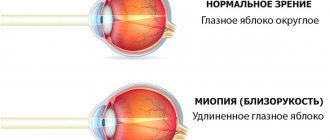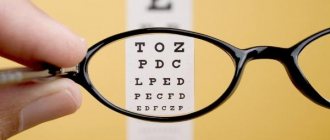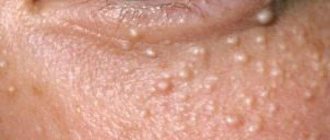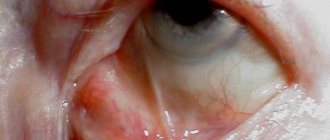General information about pathology
Myopia (or myopia) is a disorder in the functioning of the visual organs, in which a person begins to have difficulty seeing objects located at a certain distance from him. This disorder is explained by an anomaly in the structure of the eye, in which light rays are focused in front of the retina. Myopia can appear not only as a result of increased visual load, but also as a result of a hereditary factor. According to statistics, half of the couples where parents suffer from myopia have a child with the same disease. However, modern medicine offers many options for treating pathology and preventing it.
The main symptoms of myopia are decreased visual acuity and periodic headaches.
Prevention
Myopia is one of the most common vision defects in the world - every third person suffers from myopia. Moreover, the disease can develop at any age. Myopia is more common in children. This is due not only to the growth of the eye apparatus, but also to unfavorable conditions and excessive load on the visual organs of a child at school age. According to medical data, approximately a third of primary school students suffer from myopia and are forced to use corrective optics. For this reason, preventing myopia in childhood is the main step towards eye health.
Antenatal prevention
It is necessary to begin to prevent myopia in the antenatal period (pregnancy). This measure is a relevant way to prevent the development of hereditary myopia.
- It consists of consuming folic acid in the first weeks of pregnancy. Vitamin B9 (Folic acid) significantly reduces the risk of developing abnormalities in the structure of the neural tube.
- Experts also note the close relationship between the nervous system and the organs of vision and advise following all the advice of your doctor about taking vitamin B and other vitamins.
- It is mandatory to avoid smoking and drinking alcohol.
- In addition, X-rays, etc. are prohibited.
Such preventive measures significantly reduce the likelihood of myopia in a child.
In addition to antenatal prevention in medicine, there are other ways to prevent myopia.
List of measures to prevent myopia
Ophthalmology identifies the following most effective measures to prevent myopia in schoolchildren and adults:
- physiotherapy;
- exercises for the eyeball;
- exercises for the cervical spine;
- good nutrition;
- taking dietary supplements;
- the use of medicinal drops and injections under the sclera.
For each individual patient, it is worth individually selecting a set of measures. If the cause of the development of myopia is poor nutrition and a regimen in which a spasm of accommodation is inevitable, these causes should be eliminated first. When a patient is diagnosed with osteochondrosis of the cervical spine, all efforts must be made to eliminate this pathology.
Medicinal method of prevention
This method is based on the use of eye drops, as well as possible vitamin complexes that prevent deficiency of substances necessary for eye health.
Vitamins
The stable functioning of the visual organs can be affected by the lack of important vitamins.
- Retinol (also called Vitamin A) is one of the most important substances in the functioning of the visual organs. It not only affects the mucous membrane and cornea of the eyes, but is also part of a particularly sensitive pigment that affects visual acuity. A lack of retinol is quite capable of becoming an impetus for the development of visual impairment. It is important to eat foods that contain carotene, since the body is able to independently transform provitamin A into retinol. Carotene is found in huge quantities in carrots - its share is as much as 65%. In addition, it is found in sweet peppers, spinach, parsley and sea buckthorn. For normal functioning, the body needs 1.5 - 2.5 mg of retinol daily.
- Vitamin B1 or thiamine affects the nervous system and, consequently, vision. Thiamine deficiency can cause pain and pain in the eyes, and rapid fatigue of the eye muscles. You can get the required dose of thiamine by including potatoes, tomatoes, nuts and oatmeal in your diet. In total, the body requires 1.5 mg of thiamine per day.
- Vitamin B2, also called riboflavin. Its deficiency is quite capable of leading to lacrimation and causing rupture of the capillaries of the eye. A lack of vitamin B2 in the body can also result in night blindness and “sand” in the eyes. To saturate your body with riboflavin, you need to eat apples, dairy products, eggs and grains. In total, the body requires 5 mg of vitamin B2 per day.
- Vitamin B3, also called niacin, is necessary for the stable functioning of the circulatory system and optic nerves. A lack of niacin provokes deterioration of blood circulation in the optic nerves. To compensate for the lack of this vitamin, you should add legumes, meat and mushrooms to your food. In total, the body needs 15 mg daily.
- Vitamin B6, or, in other words, pyridoxine, is involved in metabolic processes at the cellular level. Metabolic disorders lead to insufficient nutrition of eye tissues, reduce cellular immunity, and lead to the development of various diseases. To saturate the body with pyridoxine, it is recommended to eat dairy products, yeast, fish, cabbage and grains. For normal functioning, the body needs only 2 mg of vitamin B6 daily.
- A lack of cyanocobalamin or vitamin B12 provokes premature aging of the eyes, increased tear production and clouding of the lens, since it has a direct effect on red blood cells and the process of their formation, that is, it controls the circulatory system. Cyanocobalamin is found exclusively in animal products - for example, in liver, egg yolk and raw milk products. To meet the body's daily needs, only 0.005 mg of vitamin B12 is required.
- In addition, carotenoids - lutein and zeaxanthin - are essential for eye health. These substances protect the eyes from ultraviolet radiation, preventing retinal damage. To saturate the body with these substances, you need to eat beans, spinach, peppers, corn and egg yolks.
- In addition to the listed biologically active substances, it is necessary to saturate the body with vitamins C, B5 and B9, which help the good absorption of trace elements and minerals.
Review of the most effective drugs
There are many options for vitamin products for vision on the shelves of pharmacies. Let's look at the most popular and effective of them. The selection of drugs is carried out by a doctor, taking into account the characteristics of each patient.
Vitrum Vision
A vitamin complex that helps normalize vision, improves perception in low light conditions, has an antioxidant effect, and prevents age-related changes in the retina. Contains vitamins, microelements, carotenoids of natural origin.
Release form: tablets.
Active components:
- lutein,
- zeaxanthin,
- ascorbic acid,
- vitamin E,
- betacarotene,
- zinc oxide,
- copper sulfate.
Dosage: 1 tablet 2 times a day, in courses.
Contraindications: individual intolerance to any of the components.
Vitalux plus
Dietary supplement. Fights signs of eye fatigue, accelerates metabolism in tissues, and replenishes the lack of vitamins and microelements. Activates cell regeneration processes, reduces the effects of stress, and slows down age-related changes.
Release form: capsules.
Active components:
- ascorbic acid,
- vitamin E,
- zinc,
- lutein,
- zeaxanthin,
- fish fat.
- docosahexaenoic acid.
Dosage: 1 capsule per day for a month.
Contraindications: individual intolerance to the components, pregnancy, breastfeeding.
Mirtikam
Homeopathic remedy based on blueberry extract. Used to improve the functional state of the retina. Has vascular strengthening and antioxidant effects. Reduces eye fatigue, improves twilight vision. Recommended for increased visual stress, as well as for elderly patients.
Release form: lozenges.
Active components:
- dry blueberry fruit extract,
- eyebright,
- gelsemium evergreen,
- black cohosh.
Dosage: 1 tablet 2 times a day after meals, course treatment.
Contraindications: individual intolerance to components, age under 18 years, pregnancy, lactation.
Strix Forte
Dietary supplement, source of anthocyanosides, vitamins and minerals. It is recommended to take it for age-related degenerative changes in the eyes, as well as to relieve symptoms of visual strain and strengthen the walls of blood vessels.
Release form: tablets.
Active components:
- blueberry extract,
- retinol,
- tocopherol,
- lutein,
- zinc,
- selenium.
Dosage: 1-2 tablets per day after meals. The course of treatment is 1-3 months.
Contraindications: individual intolerance, age under 14 years.
Doppelhertz active for eyes with lutein
Dietary supplement. Protects eyes from free radicals, improves vision and color perception, helps prevent myopia and farsightedness. Recommended for use when frequently working at a computer and being in bright light conditions.
Physiotherapy
Prevention of myopia through physiotherapeutic treatment is one of the main methods of preventing visual impairment in children and adults. The method consists of prescribing a set of procedures by the attending physician. This could be accommodation training (accommodation is focusing on objects at large and short distances). Doing the exercises daily is not difficult, but it relieves eye fatigue and develops muscles.
- First you need to close your eyes and massage your eyelids a little with your fingers.
- Next, in turn, you should perform circular movements clockwise and counterclockwise.
- Stretch your arms forward and look at your fingertips. As you inhale, raise your arms up, continue to follow them with your eyes (but avoid turning your head), exhale and lower your arms. Repeat several times.
- Find an object located at a sufficiently large distance. During eye strain, turn your gaze to this object and look for several moments.
- Close your eyes tightly for five seconds and open your eyes again for the same amount of time.
- In some cases, other procedures are prescribed.
A set of exercises for myopia
Cost of treatment
At the Moscow Eye Clinic you can undergo a full diagnostic examination and receive recommendations on the most effective treatment methods. A comprehensive examination of the patient (including methods such as testing visual acuity, biomicroscopy, autorefractometry, small-pupil ophthalmoscopy, pneumotonometry) costs 3,500 rubles.
The cost of treating progressive myopia consists of diagnostic studies, the volume of therapeutic manipulations and procedures (selection of glasses or contact lenses, laser coagulation of the retina, a course of drug therapy, hardware treatment methods, etc.), which is prescribed for each patient individually, based on the dynamics of the disease , the presence of complications, the number of hardware procedures (prices for hardware treatment of myopia start from 200 rubles per session), etc.
You can check the prices for a particular procedure or make an appointment at the Moscow Eye Clinic by phone in Moscow (daily from 9:00 to 21:00) or use the online appointment form.
Prevention of myopia in childhood and adolescence
As already mentioned, it is necessary to prevent myopia from a very early age. Preventing myopia in schoolchildren is key to continued eye health. Especially if the child has a genetic predisposition to poor vision.
Newborns
In the first year of a baby’s life, it is necessary to undergo an examination by an ophthalmologist at least three times: at three months, then at half a year and at one year, when an examination is already carried out, dilating the pupils to determine the true refraction of the eyes. If a child is at risk due to genetic indicators, examination should be performed somewhat more often.
- Lighting in a baby's room plays an important role. Playing with small toys, pictures or drawing - in poor lighting, all this increases visual strain.
- In addition, you should choose books for your child that have large and clear pictures.
- Doctors do not recommend that parents allow children to watch TV until they are three years old. After three years, it is recommended to watch TV no more than half an hour at a time. In addition, it is necessary to ensure a distance to the screen of three of its diagonals.
Preventive measures for schoolchildren
Following the above recommendations will help prevent myopia in young children. But as soon as the child goes to school, visual stress naturally increases. Therefore, the following measures are necessary:
- Posture and posture are of great importance. Teach your children to do everything at the table: write and draw. The back should be straight. In this case, the child must maintain a certain distance - it must be no less than the length of the child’s arm from elbow to hand. Ophthalmologists do not recommend reading in a supine position (for both adults and children). It is necessary to maintain a distance of 30-35 cm.
- The workplace should be equipped with additional lighting. The light in the workplace should not be dazzlingly bright or too dim to avoid increased eye strain. Soft, uniform lighting throughout the entire work area is recommended. This measure will eliminate eye discomfort when moving from dark to light objects.
- For the first reading, you need to choose books in which the font is large enough.
- In addition, one of the effective ways to prevent myopia in children during school is to change activities. The ideal would be to alternate between lessons and active games in the fresh air.
- For children at a young age, ophthalmologists also recommend engaging in active sports as a preventive measure (for example, swimming, running and cycling). This measure can also help prevent myopia in later life.
However, in addition to all the above recommendations, the main prevention of myopia in children and adolescents is also timely examinations by an ophthalmologist. Medical care should not be neglected, and if the quality of vision deteriorates, it is important to consult a doctor in time to prevent possible negative consequences.
General preventive measures
To prevent the occurrence of myopia in children and adolescents, a whole set of special measures has been developed. Implementing it will not be difficult, because it contains completely ordinary recommendations for improving the work and life of a person, such as:
- Providing comfortable conditions for the educational process and work. This is very important for both kids and adults. So, the workplace must be organized correctly so that daylight falls on the left for right-handers and on the right for left-handers. The chair should have a fairly rigid back and should not be located too high or too low relative to the table. Otherwise, constant prolonged tension in the neck muscles, as well as curvature of the spine, can lead to problems with blood flow in the vertebral arteries. And this will negatively affect visual function (existing myopia may progress). For artificial lighting sources, the location rules are the same as for natural light. It is especially important to choose a comfortable brightness of artificial light that will not irritate the eyes.
- Reasonable distribution of daytime visual loads. To avoid the development of myopia, it is necessary to give your vision proper rest, alternating work at a computer monitor, reading and writing with “physical education” or special exercises for the eyes. Simple exercises to prevent the onset of eye fatigue by alternating looking at a point near and a point in the distance (for example, at a point drawn on a window glass and a tree outside the window) will help train the accommodative apparatus and weaken the phenomena of asthenopia, which leads to false myopia.
- Balanced proper nutrition. A sufficient amount of various vitamins (A, B and C groups), polyunsaturated fatty acids, beneficial minerals (calcium, magnesium, selenium) and proteins is necessary for the normal function of the organ of vision. In this regard, the prevention of myopia implies a radical revision of the diet in favor of “healthy” natural products and vitamin complexes.
- Regular physical activity. It is better to pay due attention to this component of myopia prevention starting from childhood. Regular physical education, team games, dancing, and other types of physical activity help the harmonious development of the body, including the nervous system and the organ of vision. Physical activity activates blood flow and microcirculation in tissues and organs, allowing them to avoid hypoxia (oxygen starvation), which becomes an excellent prevention of decreased vision and myopia, among other things.











